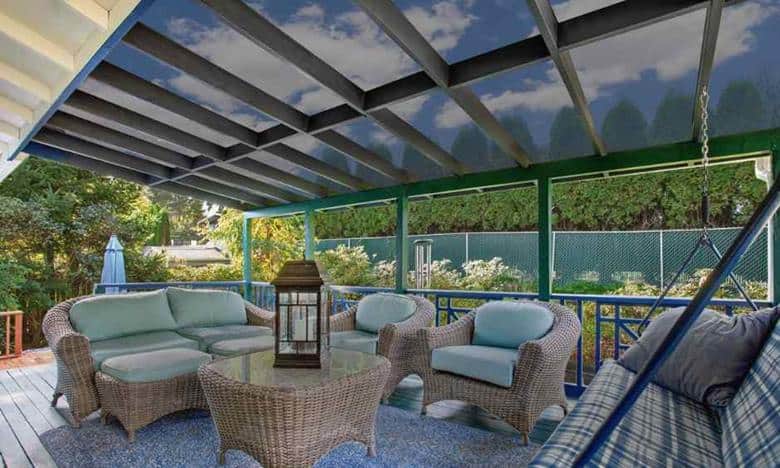Polycarbonate is a non-porous plastic utilized in a wide range of items. It includes electronics, automotive components, and building materials.
It is not a good choice for paint adhesion unless it is pre-conditioned with abrasion procedures. It is pertinent to do the preparatory process before painting to prevent the flaking of your polycarbonate roof.
Apply a proper paint coating that can withstand harsh weather conditions. Painting can rejuvenate discolored plastic, alter the original color and clean up the deteriorated plastic.
- Essentials to Paint Polycarbonate
- Method to Paint Polycarbonate Roof Panels
- Substantial Uses of Painting Polycarbonate
- Pros of Polycarbonate Roofing
- Cons of Polycarbonate Roofing
- Precautionary Measures to Paint Polycarbonate
Essentials to Paint Polycarbonate
- A pressure hose for polycarbonate
- Extension Ladder for painting
- Pair of safety boots and goggles
- Fine-grit sandpaper
- Require acrylic latex paint
- Need acrylic latex primer
- Roller and paintbrush for painting
Method to Paint Polycarbonate Roof Panels
1. Use of Acrylic Latex Paint
Acrylic latex paint is the perfect choice for painting polycarbonate roof panels. This painting keeps them from breaking as they grow and expand thermally.
Moreover, acrylic latex has resistance properties that extend its durability. However, sustaining paints for a longer time must eschew cracking.
2. Washing polycarbonate sheet
It is the first and foremost step in painting polycarbonate roof panels. Clean with a high-pressure hose. After that, it must be left for 24 hours to dry.
This method will remove the dust particles. It becomes trapped beneath the primer and the painting.
3. Use Fine-grit sandpaper
Using fine-grit sandpaper is essential for painting polycarbonate roof panels. Polycarbonate is easily scratched, which implies that the surface can ameliorate by sandpapered to create a plethora of pits and dents for the latex primer to cling.
4. Use of a Primer
Primer adheres the painting to the polycarbonate sheet. The paints will not adhere well without a primer. Apply the primer in uniform layers using a paint roller for the best results.
Furthermore, roll the latex from the roof’s edge to the apex and fill any remaining spaces with a paintbrush to make it alluring and appealing.
5. Painting on a polycarbonate sheet
After following all the steps, you can apply paint. Make sure to dry the primer, as soon as it dries for 2-3 hours, wash the roller and paintbrush.
Finally, apply the paint over cured priming to make it more appealing.
Substantial Uses of Painting Polycarbonate
1. Roof Windows allow Light into the Room
The barrel vault, box and gable, and clerestory windows are the three most prevalent forms of roof windows. Moreover, roof windows allow natural light into space-maintaining security.
2. Skylights ensure Privacy
Skylights are ideal for homes with high vaulted ceilings. The installation procedure is tough than others but may allow in natural light by maintaining security.
3. Curved Roofs provide Strength and Rigidity
Curved roofing is perfect for larger areas as vast expanses of glass are required. It provides strength and stiffness when utilized in curves.
Pros of Polycarbonate Roofing
1. Provide Strength and Rigidity
Polycarbonates can easily endure lateral and vertical forces owing to their strength and rigid properties.
They have high impact strength and can withstand huge burdens and loads without damaging, fracturing, straining, or ripping.
They can last 50-100 years owing to their high impact strength and rigidity.
2. Lighter than Glass
Interestingly, polycarbonate is approximately 40% lighter than glass. Moreover, it offers better insulation against extreme weather.
3. Heat Resistant Properties
Polycarbonate roofing performs well against extreme weather against UV radiation as UV light from the sun may highly trouble polycarbonate, thus weakening its structure and discoloration.
4. Chemical Resistance
Polycarbonates are not resistant to solvents such as gasoline or kerosene. It is resistant to alkalis, acids, and other chemicals.
It is pertinent to mention that solvents can enable the material to deteriorate quickly.
5. Perfect for Green Buildings
Polycarbonate comes from a naturally occurring substance which is carbon dioxide. Therefore, polycarbonate roofing is the ideal choice for green buildings.
In addition to this, polycarbonates can recycle once used.
Cons of Polycarbonate Roofing
1. Expensive than other roofing
The most troublesome con of polycarbonate roofing is that it is more extensive than roofing material. Therefore, it is considered a con of polycarbonate roofing.
2. Prone to Flammability
Polycarbonate is prone to flammability. Unfortunately, it cannot withstand extreme weather conditions. Usually, people do not consider it feasible. Therefore, they cannot use it in extreme weather conditions.
3. Low Resistance
Polycarbonate has low resistance therefore it cannot withstand high temperatures. Adding to it, polycarbonate is prone to deteriorate under weather fluctuations.
Moreover, the solution to this problem is to add a coat of paint thwart water damage.
Precautionary Measures to Paint Polycarbonate
1. Eschew using Solvents
Solvents are not a perfect choice to paint polycarbonate rather is will deteriorate the polycarbonate sheet. It may soften your polycarbonate sheet using solvent-based paints. Resultantly, it will give you undesirable outcomes.
2. Wipe out the Polycarbonate Sheet
Before painting, it is pertinent to clean the polycarbonate sheet with lukewarm water and detergent. The cleanliness of the sheet will give you the best results. A translucent plastic sheet has a flat surface making it hard for paint to attach.
3. Allow the Paint to Dry
Follow the drying time specified on the paint container for optimal results. It is ideal to finish the paint layer with a polyurethane-based clear coat.
Final Thoughts
Polycarbonate roofing comes from polycarbonate-a thermoplastic polymer. It has multiple properties, for example, it endures weather conditions while staying lightweight.
You can paint polycarbonate roofing by using acrylic latex paint and primer. To encapsulate, it is pertinent to wash the roofing and use fine-grit sandpaper before applying the paint as it will ensure longevity and an appealing look.

